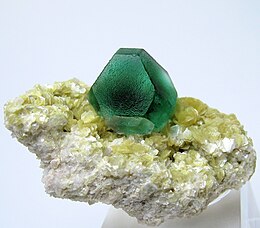The word fluorite is derived from the Latin verb fluere, meaning to flow. The mineral is used as a flux in iron smelting to decrease the viscosity of slag. The term flux comes from the Latin adjective fluxus, meaning flowing, loose, slack. The mineral fluorite was originally termed fluorspar and was first discussed in print in a 1530 work Bermannvs sive de re metallica dialogus [Bermannus; or dialogue about the nature of metals], by Georgius Agricola, as a mineral noted for its usefulness as a flux. Agricola, a German scientist with expertise in philology, mining, and metallurgy, named fluorspar as a Neo-Latinization of the German Flussspat from Fluss (stream, river) and Spat (meaning a nonmetallic mineral akin to gypsum, spærstān, spear stone, referring to its crystalline projections).
In 1852, fluorite gave its name to the phenomenon of fluorescence, which is prominent in fluorites from certain locations, due to certain impurities in the crystal. Fluorite also gave the name to its constitutive element fluorine.Currently, the word “fluorspar” is most commonly used for fluorite as an industrial and chemical commodity, while “fluorite” is used mineralogically and in most other senses.
In archeology, gemmology, classical studies, and Egyptology, the Latin terms murrina and myrrhina refer to fluorite. In book 37 of his Naturalis Historia, Pliny the Elder describes it as a precious stone with purple and white mottling, and noted that the Romans prized objects carved from it. It has been suggested that the Sanskrit mineral name vaikrānta (वैक्रान्तः), known from Sanskrit alchemical texts dating from the early second millennium CE onwards, may refer to fluorite.


